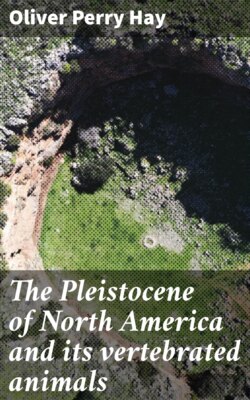Читать книгу The Pleistocene of North America and its vertebrated animals - Oliver Perry Hay - Страница 53
На сайте Литреса книга снята с продажи.
Оглавление(Map 3.)
1. Bigbone Lick, Boone County.—In 1831, Dr. Richard Harlan (Monthly Amer. Jour. Geol., vol. I, p. 77, plate III, figs. 1 to 3) described a left ramus of the lower jaw of a ground-sloth which had been brought to New York. This jaw he referred to his Megalonyx laqueatus (M. jeffersonii); but it was later shown by Owen (Zool. Beagle, 1840, p. 68) to belong to Mylodon, and he named it M. harlani in honor of Dr. Harlan. From Cooper (Monthly Amer. Jour. Geol., vol. I, p. 172) it is learned that this bone had formed part of the Finnell collection at Cincinnati. So far as the present writer sees, there was nothing in Harlan’s article to show where the jaw was discovered. In 1855 (Smithson. Contrib. Knowl., vol. VII, p. 47, plate XIV, figs. 1, 2), Leidy further described and illustrated the specimen and stated that it was found at Bigbone Lick. In 1903, Barnum Brown (Bull. Amer. Mus. Nat. Hist., vol. XIX, p. 511) stated that Harlan’s specimen ought to be in Columbia University, but it could not be found. It is more probable that it was destroyed in a fire in the old American Museum of Natural History.
In his report on Bigbone Lick (op. cit., p. 171), Cooper stated that he had seen in the “Western Museum,” Cincinnati, a large humerus of a megalonyx. Cooper further wrote that he and a companion had found at the lick a metacarpal bone which he supposed belonged to the same animal. The humerus was described and figured by Harlan (Jour. Acad. Nat. Sci., Phila., ser. 1, vol. VI, p. 277, plate XIII, fig. 10). Cooper (op. cit., p. 172) mentions other bones of Megalonyx found at Bigbone Lick, but some may have belonged to Mylodon. This is the case with the fragment of lower jaw with 4 teeth which became the type of Mylodon harlani, as above mentioned. In Princeton University there is an ungual phalanx 167 mm. long, 66 mm. high, and 43 mm. thick at the middle of the height. This is labeled as having been found at Bigbone Lick. A list of the species discovered at this place will be found on page 403.
2. Bluelick Springs, Nicholas County.—In the collection made by Mr. Thomas W. Hunter, in the sulphur spring at the place mentioned, the writer has seen two ungual phalanges which were identified as those of Megalonyx jeffersonii.
3. Henderson, Henderson County.—A considerable part of a skeleton of Megalonyx jeffersonii was found at different times extending through some years, about 5 or 6 miles below Henderson, in the bank of Ohio River. This skeleton is now in the University of Indiana and was described by Leidy in 1855 (Smithson. Contrib. Knowl., vol. VII, art. 3). This collection furnished a fine skull and lower jaw. In the same deposits were found many horns and bones of deer. The geology of the locality and the age of the bones will be discussed on page 405.
